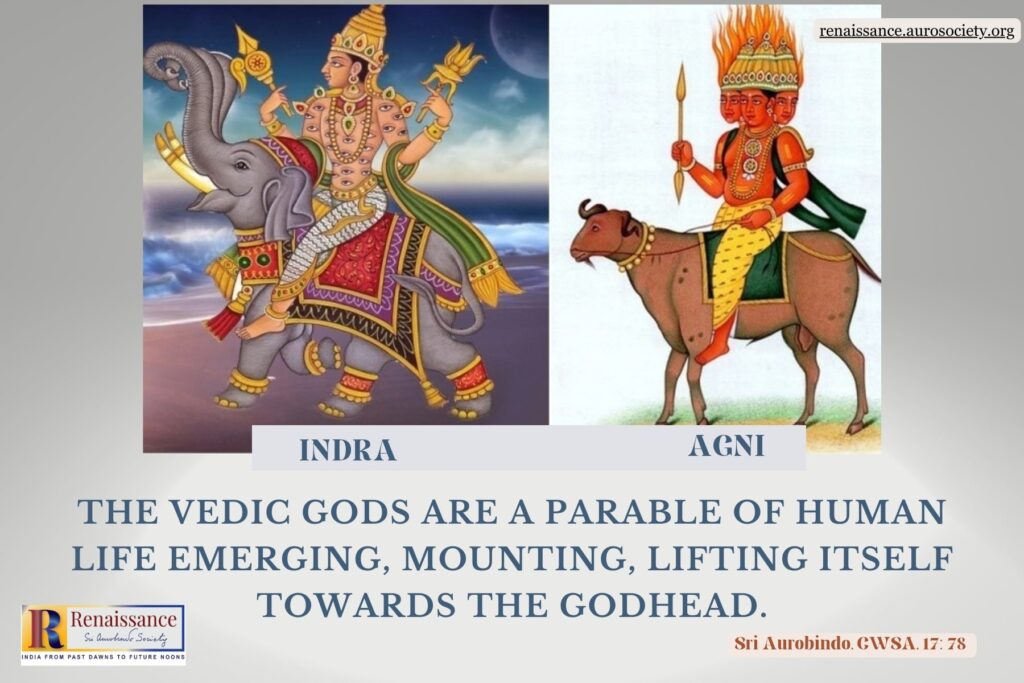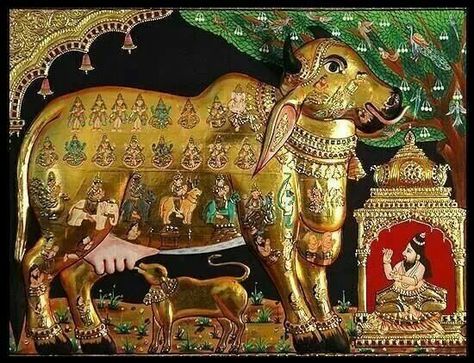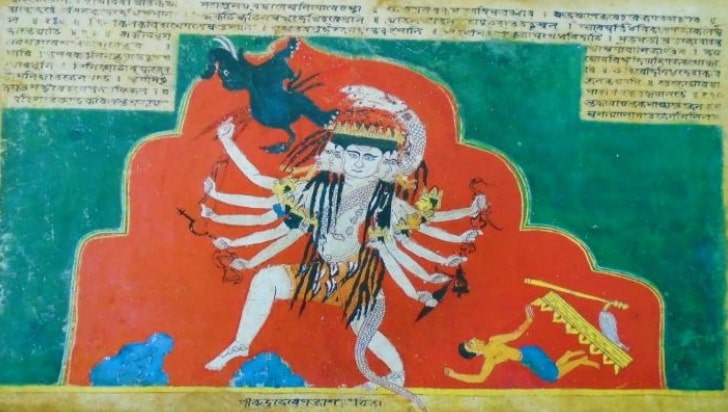Volume V, Issue 1
Author: Beloo Mehra
Continued from PART 1


Ribhus
In the Veda, the Ribhus (Ṛbhus), the rays of the Sun, are the “Artisans of Immortality”. They are represented as the human beings who have attained to the conditions of godhead by the power of knowledge and perfection in their works.
Ribhus are brothers. The eldest is Ribhu or Ribhukshan, the skillful knower or shaper in knowledge. The second one is Vibhu, the pervading or the self-diffusing. And the third is Vaja, the plenitude.
Since the Ribhus represent the human aspiration for immortality, they are also connected with Indra. It is Indra who as the Divine Mind impels in the human being the aspiration for immortality. Ribhus, the ancient human beings, are those who had successfully accomplished those works and formations which prepared them for Immortality.
These works and formations are described symbolically as: the horses of Indra; the car or chariot of Ashwins; the Cow that gives the sweet milk; the youth of the universal Parent; and the multiplication into four of the one drinking-bowl of the gods originally fashioned by Twashtri (Tvaṣṭṛ), the framer of things. A summary of the deeper meaning of some of these works and formations of the Ribhus is given below.
Indra’s Horses
Free movement of the luminous mind of Indra is a necessary condition for accomplishing immortalizing works. Horses indicate free movement, but horses are to be united, controlled and guided by knowledge, by the Word and by Speech. In other words, the horses are to be fashioned by the mind. Hence, the nature of Indra’s horses is luminous.
The works and formations which are necessary to prepare the state of immortality are:
- to develop the power of the divine mind
- to convert the energies of action by the light of the divine mind
- to control the movement of the horses by the Word, and
- to accomplish the work of the sacrifice, yajña, which symbolizes the upward journey in which human capacities and energies are offered for an upper evolution by means of progressive descent and manifestation of Truth.

Ashwins’ Chariot
Ashwins are described as the Twin Lords of the Human Voyage. They have all-pervading movement and are thus able to help human beings in their journey. The movement of Ashwins is a movement of Ananda that always bestows health, youth, strength, wholeness to the physical man. It bestows capacity of action and enjoyment to the vital being, and imparts energy of the light to the mental being.
The chariot of the Ashwins is represented by the rising wave that emerges from the ocean of the inconscient. To fashion the chariot of the Ashwins means to provide to the physical, vital and mental members of the human personality the force of the pure delight of the being.
Only by a tremendous training and cultivation of the body, life and mind, and by a great purification of these parts of the being the force of the pure delight, the boon of the Ashwins, can be brought in the instrumental personality. This is what the Ribhus accomplished, and thus fulfilled the condition of the attainment of the state of immortality.
Aditi, the Cow

Image: Aditi, the Cow with her offspring, Tanjore style painting, source Pinterest
Aditi, the Cow, represents the Infinite Consciousness or the infinite conscious Being which is the Mother of the worlds.
Ribhus’ work of fashioning this cow that gives sweet milk symbolizes the manifestation of the universal forms of the light of Aditi, the Cow.
In the lower world of matter, life and mind, because of the action of the powers of the duality and the veiling movement of Nature, Aditi or Infinite Consciousness gets separated from her offspring, the soul. The Ribhus fashion a figure of her in us, which essentially means restoring our lower nature to constant companionship with its infinite mother. It is through Aditi’s intervention that the inferior nature of man, which is mortal, is transformed into the higher nature of unity and infinity, which is immortal.

The Vedic Trinity: Vishnu-Rudra-Brahmanaspati
The Veda does not distinguish between the supreme Trinity and the lesser gods. To the Vedic Rishis there was only one universal Deva. And Vishnu, Rudra, Brahmanaspati, Agni, Indra, Vayu, Mitra, Varuna are all alike its forms and cosmic aspects. Each of them is in himself the whole Deva and contains all the other gods.
In an important passage in The Secret of the Veda Sri Aurobindo speaks of a common misunderstanding people have about some of the Vedic gods, especially Vishnu and Rudra.
It was a view long popularised by European scholars that the greatness of Vishnu and Shiva in the Puranic theogonies was a later development and that in the Veda these gods have a quite minor position and are inferior to Indra and Agni. It has even become a current opinion among many scholars that Shiva was a later conception borrowed from the Dravidians and represents a partial conquest of the Vedic religion by the indigenous culture it had invaded.
These errors arise inevitably as part of the total misunderstanding of Vedic thought for which the old Brahmanic ritualism is responsible and to which European scholarship by the exaggeration of a minor and external element in the Vedic mythology has only given a new and yet more misleading form.
The importance of the Vedic gods has not to be measured by the number of hymns devoted to them or by the extent to which they are invoked in the thoughts of the Rishis, but by the functions which they perform.
Agni and Indra to whom the majority of the Vedic hymns are addressed, are not greater than Vishnu and Rudra, but the functions which they fulfil in the internal and external world were the most active, dominant and directly effective for the psychological discipline of the ancient Mystics; this alone is the reason of their predominance….
On the other hand, Vishnu, Rudra, Brahmanaspati, the Vedic originals of the later Puranic Triad, Vishnu-Shiva-Brahma, provide the conditions of the Vedic work and assist it from behind the more present and active gods, but are less close to it and in appearance less continually concerned in its daily movements.
~ CWSA, Vol. 15, p. 344
* * *

* * *
Brahmanaspati is the creator by the Word. He calls light and visible cosmos out of the darkness of the inconscient ocean. And he speeds the formations of conscious being upward to their supreme goal. From this creative aspect of Brahmanaspati arose the later conception of Brahma, the Creator.
Rudra supplies the force for the upward movement of Brahmanaspati’s formations.
Named in the Veda as the Mighty One of Heaven, Rudra is the Violent One who leads the upward evolution of the conscious being. His force battles against all evil, smites the sinner and the enemy. He breaks down all defective formations of outward and inward life.
Rudra is the most terrible of the gods. He is the one of whom alone the Vedic Rishis have any real fear. But there is also a benign side to this violent and mighty Rudra. He is the supreme healer. Opposed, he destroys, but when called on for aid and propitiated he heals all wounds and all evil and all sufferings.
* * *

source: Wikicommons
* * *
It is Vishnu who supplies the necessary static elements, — Space, the ordered movements of the worlds, the ascending levels, and the highest goal for the formations of Brahmanaspati’s word and for the actions of Rudra’s force. He has taken three strides and in the space created by the three strides has established all the worlds. In these worlds, Vishnu, the all-pervading dwells and gives less or greater room to the action and movements of the gods.
The Rig Vedic hymn 1.154 of Dirghatamas Auchathya is dedicated to the all-pervading Vishnu. This hymn celebrates the greatness of Vishnu’s three strides.
विष्णोर्नु कं वीर्याणि प्र वोचं यः पार्थिवानि विममे रजांसि ।
यो अस्कभायदुत्तरं सधस्थं विचकमाणस्त्रेधोरुगायः ॥१॥
Of Vishnu now I declare the mighty works, who has measured out the earthly worlds and that higher seat of our self-accomplishing he supports, he the wide-moving, in the threefold steps of his universal movement.
(Rig Veda I.154.1, Translation by Sri Aurobindo)
* * *
The supreme step of Vishnu, his highest seat, is the triple world of bliss and light, priyaṁ padam, which the wise ones see extended in heaven like a shining eye of vision; it is this highest seat of Vishnu that is the goal of the Vedic journey. Here again the Vedic Vishnu is the natural precursor and sufficient origin of the Puranic Narayana, Preserver and Lord of Love.
[…]In this hymn of Dirghatamas Auchathya to the all-pervading Vishnu it is his significant activity, it is the greatness of Vishnu’s three strides that is celebrated. We must dismiss from our minds the ideas proper to the later mythology. We have nothing to do here with the dwarf Vishnu, the Titan Bali and the three divine strides which took possession of Earth, Heaven and the sunless subterrestrial worlds of Patala.
The three strides of Vishnu in the Veda are clearly defined by Dirghatamas as earth, heaven and the triple principle, tridhātu. It is this triple principle beyond Heaven or superimposed upon it as its highest level, nākasya pṛṣṭhe, which is the supreme stride or supreme seat of the all-pervading deity.
~ Sri Aurobindo, CWSA 15: 346-8
* * *

Earth (physical plane), the mid-world (vital/life-plane) and heaven (mental plane) are the triple place of the conscious being’s progressive self-fulfilling. Earth the lower seat, the vital world the middle, heaven the higher – all these are contained in the threefold movement of Vishnu.
But the highest world, the world of superconscient bliss is where the self-fulfilment is accomplished, Vishnu’s highest stride.
* * *
Sri Aurobindo’s prayer
In a beautiful aphorism, Sri Aurobindo once penned a prayer to some of the Vedic gods invoking their deeper psycho-spiritual force and power to be bestowed upon an aspirant.
Be wide in me, O Varuna; be mighty in me, O Indra; O Sun, be very bright and luminous; O Moon, be full of charm and sweetness.
~ Sri Aurobindo, CWSA, Vol. 12, p. 429
Be fierce and terrible, O Rudra; be impetuous and swift, O Maruts; be strong and bold, O Aryama; be voluptuous and pleasurable, O Bhaga; be tender and kind and loving and passionate, O Mitra.
Be bright and revealing, O Dawn; O Night, be solemn and pregnant.
O Life, be full, ready & buoyant; O Death, lead my steps from mansion to mansion.
Harmonise all these, O Brahmanaspati.
Let me not be subject to these gods, O Kali.
The Mother in her comment on this aphorism, said that in this prayer Sri Aurobindo makes Kali the great liberating power who ardently impels aspirant towards progress and leaves no ties within which would hinder one from progressing. She called this prayer “a good subject for meditation.” (CWM, Vol. 9, p. 377)
As we conclude our exploration (admittedly we have only covered some of the Vedic gods and goddesses), it is important to remind ourselves how Sri Aurobindo explains the psychological basis on which the various Vedic gods and goddesses have been assigned their functions to help the aspiring man walk the path of Yoga.
…it seems to me that the Europeans are demonstrably wrong in laying so predominant a stress on the material aspects of the Vedic gods. I find Varuna and Mitra to be mainly moral and not material powers; Surya, Agni, Indra have great psychical functions; even Sarasvati, in whom the scholars insist on seeing, wherever they can, an Aryan river, presents herself as a moral and intellectual agency,…
But there is an even more important truth than the high moral and spiritual significance of the Vedic gods and the Vedic religion… the moral functions assigned to these gods are arranged not on a haphazard, poetic or mythological basis, but in accordance with a careful, perhaps even a systematised introspective psychology and that at every step the details suggested agree with the experiences of the practical psychology which has gone in India from time immemorial by the name of Yoga.
~ Sri Aurobindo, CWSA, Vol. 17, pp. 327-328

READ PART 1

~ Design: Beloo Mehra



